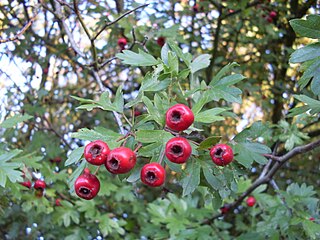
The birds-of-paradise are members of the family Paradisaeidae of the order Passeriformes. The majority of species are found in eastern Indonesia, Papua New Guinea, and eastern Australia. The family has 45 species in 17 genera. The members of this family are perhaps best known for the plumage of the males of the species, the majority of which are sexually dimorphic. The males of these species tend to have very long, elaborate feathers extending from the beak, wings, tail, or head. For the most part, they are confined to dense rainforest habitats. The diet of all species is dominated by fruit and to a lesser extent arthropods. The birds-of-paradise have a variety of breeding systems, ranging from monogamy to lek-type polygamy.

The crested shelduck, or Korean crested shelduck, is a species of bird in the family Anatidae. It is critically endangered. The male crested shelduck has a greenish-black crown, breast, primaries, and tail, while the rest of its face, chin, and throat are brownish black. The male's belly, undertail coverts, and flanks are a dark grey with black striations. The upper wing coverts are white, while its speculum is an iridescent green. The female has a white eye ring, black crest, white face, chin, throat, neck, and uppers wing coverts and a dark brown body with white striations. Additionally, both sexes have a distinctive green tuft of feathers protruding from the head.

Crataegus monogyna, known as common hawthorn, one-seed hawthorn, or single-seeded hawthorn, is a species of flowering plant in the rose family Rosaceae. It is native to Europe, northwestern Africa, and Western Asia, but has been introduced in many other parts of the world.

The Choiseul pigeon is an extinct species of bird in the pigeon and dove family, Columbidae. It was endemic to the island of Choiseul in the Solomon Islands, although there are unsubstantiated reports that it may once have lived on several nearby islands. The last confirmed sighting was in 1904. Other common names were Solomons crested pigeon, Solomon Islands crowned-pigeon and Kuvojo.

A bird hybrid is a bird that has two different species as parents. The resulting bird can present with any combination of characteristics from the parent species, from totally identical to completely different. Usually, the bird hybrid shows intermediate characteristics between the two species. A "successful" hybrid is one demonstrated to produce fertile offspring. According to the most recent estimates, about 16% of all wild bird species have been known to hybridize with one another; this number increases to 22% when captive hybrids are taken into account. Several bird species hybridize with multiple other species. For example, the mallard is known to interbreed with at least 40 different species. The ecological and evolutionary consequences of multispecies hybridization remain to be determined.

The magnificent bird-of-paradise is a species of bird-of-paradise. The magnificent bird-of-paradise is evaluated as Least Concern on the IUCN Red List of Threatened Species. They are listed in Appendix II of CITES.

The greater lophorina, formerly a subspecies of the superb bird-of-paradise, is a species of passerine bird in the bird-of-paradise family Paradisaeidae. It is found in the central and northeast montane regions of New Guinea.

Maria's bird-of-paradise, also known as Frau Reichenow's bird-of-paradise or Mrs. Reichenow's bird-of-paradise, is a bird in the family Paradisaeidae that is a presumptive hybrid species between an emperor bird-of-paradise and raggiana bird-of-paradise. It was named for the wife of the describer, German ornithologist Anton Reichenow.
Rothschild's bird-of-paradise is a bird in the family Paradisaeidae that is a hybrid between a raggiana bird-of-paradise and lesser bird-of-paradise. It was named after British ornithologist Walter Rothschild.

The astrapian sicklebill, also known as the green-breasted riflebird, is a bird in the Paradisaeidae family that was proposed by Erwin Stresemann to be an intergeneric hybrid between an Arfak astrapia and black sicklebill, an identity since confirmed by DNA analysis.

Elliot's bird of paradise is a bird in the family Paradisaeidae, first described by Edward Ward in 1873, but which was later proposed to be a hybrid rather than a “real” species, an identity since confirmed by DNA analysis.
The false-lobed astrapia, also known as the false-lobed long-tail, is a bird in the family Paradisaeidae that was proposed by Erwin Stresemann to be an intergeneric hybrid between a long-tailed paradigalla and black sicklebill. Another interpretation that has been put forward is that the only known specimen is an immature Elliot's bird-of-paradise. However, a 2024 DNA study found that it is an F1 hybrid between a long-tailed paradigalla and an Arfak astrapia.
The mysterious bird of Bobairo, named as such by Errol Fuller, is a bird in the family Paradisaeidae that is presumed to be an intergeneric hybrid between a black sicklebill and greater lophorina. Only one adult male specimen is known of this bird, and is held in the Netherlands National Museum of Natural History in Leiden. It derives from Bobairo, near Enarotali on Lake Paniai in the Weyland Mountains of Western New Guinea.
Sharpe's lobe-billed parotia, also known as Sharpe's lobe-billed riflebird, is a bird in the family Paradisaeidae that Erwin Stresemann proposed is an intergeneric hybrid between a long-tailed paradigalla and western parotia, an identity confirmed by DNA analysis.

Wilhelmina's bird-of-paradise, also known as Wilhelmina's riflebird, is a bird in the family Paradisaeidae that Erwin Stresemann proposed is an intergeneric hybrid between a greater lophorina and magnificent bird-of-paradise, an identity since confirmed by DNA analysis.

Bensbach's bird-of-paradise, also known as Bensbach's riflebird, is a bird in the family Paradisaeidae that is often now considered an intergeneric hybrid between a magnificent riflebird and lesser bird-of-paradise. However, some authors, such as Errol Fuller, believe that it was a distinct and possibly extinct species.
Ruys's bird-of-paradise is a bird in the family Paradisaeidae that is presumed to be an intergeneric hybrid between a magnificent bird-of-paradise and lesser bird-of-paradise, an identity since confirmed by DNA analysis.

Errol Fuller is an English writer and artist who lives in Tunbridge Wells, Kent. He was born in Blackpool, Lancashire, grew up in South London, and was educated at Addey and Stanhope School. He is the author of a series of books on extinction and extinct creatures.













